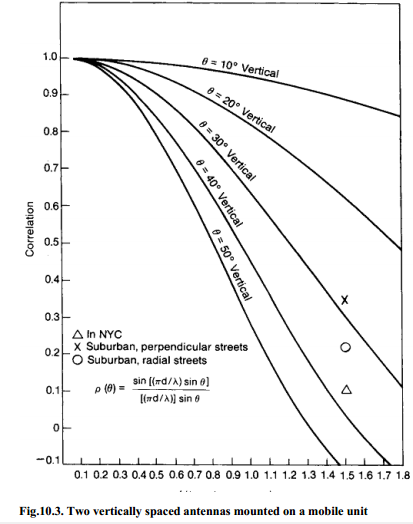Explain the following, (a) Horizontal oriented space diversity antenna (b) Vertically Oriented space diversity antenna
10. Explain the following,
(a) Horizontal oriented space diversity antenna
(b) Vertically Oriented space diversity antenna.
(a)Horizontally Oriented Space-Diversity Antennas:
A two-branch space-diversity receiver mounted on a motor vehicle has the advantage of reducing fading and thus can operate at a lower reception level. The advantage of using a space-diversity receiver to reduce interference. The discussion here concerns a space-diversity scheme in which two vehicle-mounted antennas separated horizontally by 0.5λ wavelength (15 cm or 6 in) can achieve the advantage of diversity. We must consider the following factor. The two antennas can be mounted either in line with or perpendicular to the motion of the vehicle. Theoretical analyses and measured data indicate that the inline arrangement of the two antennas produces fewer level crossings, that is, less fading, than the perpendicular arrangement does. The level crossing rates of two signals received from different horizontally oriented space-diversity antennas are shown in Fig.10.1.
(b) Vertically Oriented Space-Diversity Antennas:
The vertical separation between two space-diversity antennas can be determined from the correlation between their received signals. The positions of two antennas X1 and X2 are shown in Fig.10.2. The theoretical derivation of correlation is
Equation is plotted in Fig.10.3. A set of measured data was obtained by using two antennas vertically separated by 1.5λ wavelengths. The mean values of three groups of measured data are also shown in Fig. 10.3. In one group, in New York City, low correlation coefficients were observed. In two other groups, both in New Jersey, the average correlation coefficient for perpendicular streets was 0.35 and for radial streets, 0.225. The following table summaries the correlation coefficients in different areas and different street orientations.
From Fig.10.3 we can also see that the signal arrives at an elevation angle of 29◦ in the suburban radial streets and 33◦ in the suburban perpendicular streets. In New York City the angle of arrival approaches 40◦






